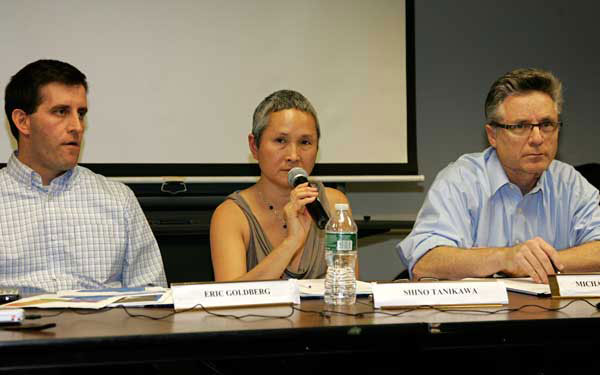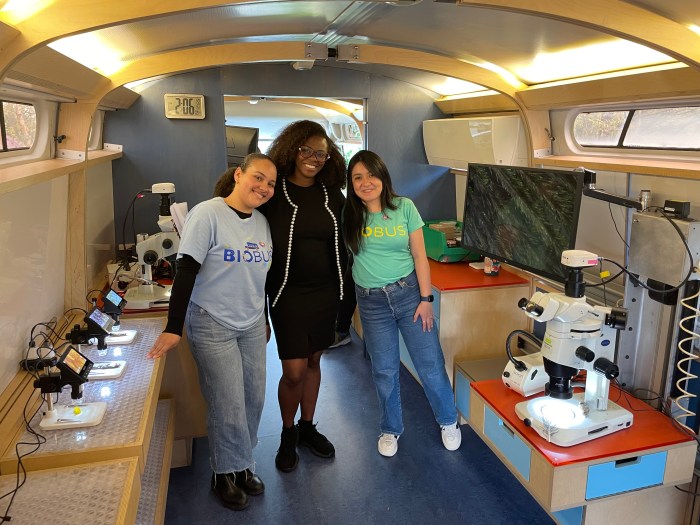
BY SAM SPOKONY | Amid continued opposition from some parents and teachers, the District 2 Community Education Council on Dec. 6 approved a sweeping rezoning that will carve out catchment areas for two new public elementary schools, and will affect zones for current schools from the West Village all the way to the Upper East Side.
Most community criticism of the District 2 rezoning effort has been centered on the portion of the plan that creates a zone for P.S. 340, the new school located at W. 17th St. and Sixth Ave., which is scheduled to open in 2014 and has been dubbed the Foundling School because it will occupy the first six floors of the New York Foundling Hospital building.
By assigning a catchment area that it believes will be large enough to sustain the Foundling School, the city’s Department of Education has said it hopes to alleviate the serious overcrowding impacting P.S. 3 and P.S. 41 in the West Village.
But in doing so, the D.O.E. 2014 plan also removes the stretches of 12th and 13th Sts. east of Greenwich Ave. from the currently shared P.S. 3/P.S. 41 zone, and funnels them into that of the Foundling School.
Parents who live on 12th and 13th Sts. have repeatedly spoken against this element of the plan, because many feel it is dangerous to force children to cross busy 14th St. intersections, and also because many think that the new boundary will have a negative effect on their children’s relationship with the overall Greenwich Village community.
But C.E.C. members saw benefits in the rezoning that they felt outweighed the concerns.
“In the end, our charge is to do what’s fairest for the most people,” said C.E.C. member Michael Markowitz before the vote, adding that he was in favor of creating a sizable, defined zone for the Foundling School in order to prevent problematic under-enrollment there.
Eric Goldberg, another member of the council, elaborated by explaining that the process that led to drawing the 12th St. boundary was essentially focused on making the Foundling School’s zone a sustainable one.
“If it’s not sustainable, it’s really going to hurt that school in the future,” he said. “We had to look into the overcrowded areas to find enough space for that, and we cut out what we felt would be natural choices to make this work.”
D.O.E. representative Drew Patterson was also at the vote to give a final explanation of why the decision was made to split up the Village school zone.
“We took a hard look at [12th and 13th Sts.] for many months,” Patterson said. “It comes down to the fact we need to alleviate [overcrowding at] P.S. 3 and P.S. 41, and cutting from the northern part of that zone is the only way we can do that.”
Under the approved plan, the Foundling School’s overall zone will have an easternmost boundary of Park Ave. South/Fourth Ave., starting from the north at E. 23rd St., and a southernmost boundary of 12th St./Greenwich Ave., finishing at its westernmost point at the intersection of W. 14th St. and Eighth Ave.
The northwest boundary of the Foundling School’s zone will cut a jagged path — along W. 14th St. between Eighth and Seventh Aves.; along Seventh Ave. between W. 14th and W. 18th Sts.; along W. 18th St. between Seventh and Fifth Aves.; along Fifth Ave. between W. 18th and W. 23rd Sts.; and along E. 23rd St. between Broadway and Park Ave. South.
In addition to downsizing the shared P.S. 3/P.S. 41 area, the rezoning will affect the catchment area sizes of P.S. 11, in Chelsea, and P.S. 130, near Chinatown, by slightly increasing the former and decreasing the latter. The plan also rearranges the zone allotted to Gramercy’s P.S. 40, whose principal, Susan Felder, had been an outspoken critic of D.O.E.’s proposals.
The other portion of the rezoning approved by the C.E.C. on Dec. 6 will make way for a new elementary school in Murray Hill that is scheduled to open in 2013.
That school, P.S. 281, under construction at E. 35th St. and First Ave., will also have an effect on the P.S. 40 zone, as well as on three other schools — P.S. 116, P.S. 59 and P.S. 267 — whose current zones collectively span from Kips Bay to the Upper East Side.
Better data needed
Although the rezoning plans for both new schools were approved, both resolutions stated that the C.E.C. believes that D.O.E.’s projections are “based on inappropriate assumptions and are not at the scale adequate for school rezoning, making it difficult to render decisions.”
To that end, the resolutions call on D.O.E. to work with the C.E.C. to improve enrollment projections for both the Foundling School and P.S. 281, in order to provide a more accurate assessment of the new schools’ capacity needs. In addition, the C.E.C. requested that D.O.E. closely monitor application and enrollment trends at all schools affected by the rezoning in future years, to determine if the boundaries have in fact been properly drawn.
Those additions to the resolutions are direct acknowledgements of the many complaints by both parents and teachers regarding the fact that D.O.E. redrew the boundaries now, rather than waiting another year or two in order to gather more data within the areas immediately surrounding the new schools.
It’s unclear at this point whether D.O.E. actually plans to heed those calls and work with the C.E.C. to compile additional data.
When asked how the department will approach future assessments of the affected areas, given the concerns and requests noted by the C.E.C. in its resolution, a D.O.E. spokesperson responded simply by describing the standard process used to project zone sizes.
“We project zone sizes by analyzing how many students currently live in the school zone; analyzing trends in population growth or decline; factoring new residential projects that may yield additional student population growth; and applying an assumed rate of retention or demand within the zone,” the spokesperson said — though not mentioning anything about working with the C.E.C. to gather more data for zones affected by the Foundling School or P.S. 281.
P.S. 40 representatives had been especially vocal about a perceived need for more study before taking action, because D.O.E.’s 2013 and 2014 plans both entail shifts to the E. 20th St. school’s zone. This means that, in back-to-back years, the Gramercy-area school will have to deal with enrolling different student populations — a troublesome prospect for administrators and teachers, as well as the parents who may be caught off guard by the multiple shifts.
‘It’s sited incorrectly’
While many parents on 12th and 13th St. remain incensed by the notion that their children may be, to some degree, cut off from the Greenwich Village community by having to attend a Chelsea school, one of those parents believes that the primary problem that led to that situation has been glossed over throughout the debate.
Davide Gentile, who lives on E. 12th St., between Broadway and Fifth Ave., and has a 6-month-old son, said he thinks that the real issue isn’t that the boundaries are being drawn incorrectly, but that W. 17th St. and Sixth Ave. just isn’t such a good place to put a new elementary school right now.
“It’s just sited incorrectly,” said Gentile, who also represents the E. 12th and 13th St. Block Association. “If the point is to reduce overcrowding, the school belongs somewhere in between the two overcrowded schools, not up by P.S. 11.”
He went on to assert that, ideally, the new elementary school should in fact be located “somewhere near the N.Y.U. core.” Gentile noted that the ever-expanding university actually promised to build a Village elementary school all the way back in 1960 — he was citing the words of former City Councilmember Carol Greitzer, who recently wrote about that promise in this newspaper.
That promise was basically used as a peace offering to the community, as N.Y.U. was attempting its initial expansion in the Village in 1960, after the developer of Washington Square Village allowed the university, through negotiations, to take over that complex as well as several other undeveloped blocks.
But now, over a half century later, that pledge has of course gone unfulfilled — and Gentile says that’s not fair.
“I’m just not happy because this school is being put in the wrong place because of this problem,” he said. “I don’t like to vilify N.Y.U., but the fact is that they’ve been punting on this for 50 years. And if we just had another elementary school right in the Village, we wouldn’t even have to have this debate over chopping out the top of the Village in a rezoning plan.”
Having said that, Gentile explained that he believes the Foundling School will almost certainly end up being a very good school in terms of performance. But given all of the disputes that have gone into finding its zone, the real question, he noted, is when that potential will be realized.
“Will it happen in the first year,” Gentile asked, “or in 10 years, or in 20?”
To split or not to split
Now that the rezoning plans for both the Foundling School and P.S. 281 have been approved, the C.E.C. still needs to vote on another D.O.E. proposal — namely, a split in the P.S. 3 and P.S. 41 zone, which currently allows Village parents to choose either one of the two schools.
By splitting the relatively large zone, D.O.E. has said it aims to further alleviate both overcrowding and administrative enrollment issues in the two schools.
Some parents and teachers — mainly from P.S. 41, which is the more overcrowded school — believe that a split would be effective in solving those problems. But others think the benefit of choice that comes with a shared zone is too valuable to lose. Still others think that a split — which wouldn’t actually decrease the overall area of the two combined separate zones — would simply have no effect on overcrowding.
The C.E.C. will vote on whether to split the remainder of the Village zone at its meeting on Wed., Dec. 19, at 6:30 p.m., at 351 W. 18th St. The first portion of the meeting will be open for community feedback on the proposal.

















